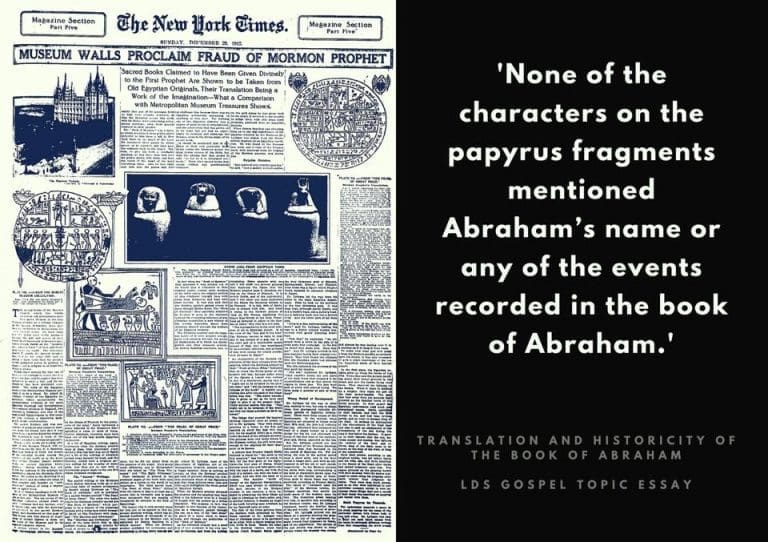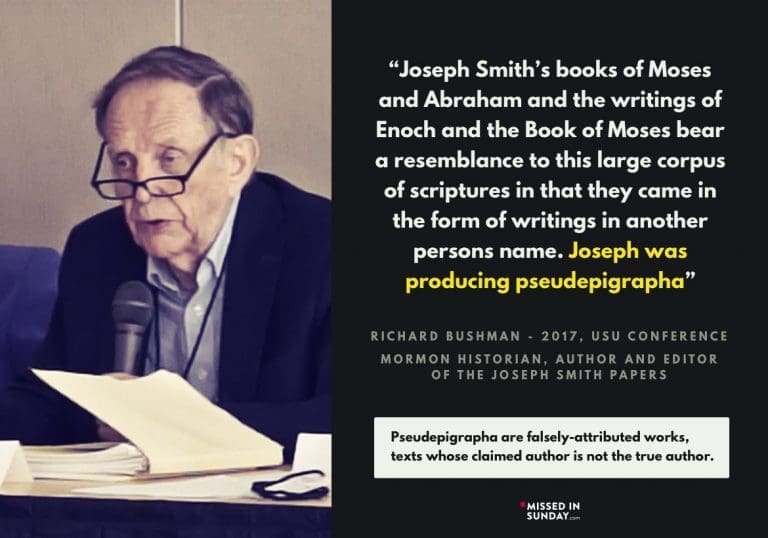The Book of Abraham is a document unique to Mormonism. The fact that the actual source papyri has been thoroughly compared to Smith’s purported translation provides a valuable opportunity to evaluate his abilities as an inspired translator of ancient languages. This essay will guide the reader through the true origins of the book, deconstruct important truth claims and just a few of the most commonly proffered theories put forth to salvage the scripture.
The LDS Church acknowledges in its Gospel Topics Essay: Historicity of the Book of Abraham that “none of the characters on the papyrus fragments mentioned Abraham’s name or any of the events recorded in the book of Abraham.” If only the lack of reference to Abraham were the problem, yet virtually everything Smith translated or sketched relating to the text and facsimiles is incorrect. As it pivots away from the literal translation process Joseph Smith pursued, the Church now declares the Book of Abraham to be an inspired attempt to understand God’s workings with man, a revelation about the ancient world and the historical figure of Abraham.
The LDS Church is understandably committed to defending its unique scripture by any means necessary, as it is difficult to see how the work can be abandoned as the literal translation Joseph Smith claimed it to be without concluding that he was a fraud. Of the numerous items Joseph claimed to translate, the Kinderhook Plates episode aside, the Egyptian papyri are the only remaining physical objects scholars can reliably evaluate. As with The Book of Mormon and other ‘translation’ projects that Joseph Smith worked on, the Book of Abraham cannot be defended in any way as the result of provable or scientific information about Abraham or the ancient world.
While the Book of Abraham often generates the most lengthy and contorted apologetic explanations, this essay is intentionally brief, focusing on the core facts of the situation. This episode is among the most instructive in LDS history, thus the reader is encouraged to explore additional resources. Dr. Robert Ritner, Ph.D., Egyptologist, University of Chicago concisely defines the LDS Church’s dilemma: “Except for those willfully blind, the case is closed.”
LEARN MORE:
- Bill Reel provides a fantastic visual summary of Book of Abraham challenges
- Translation and Historicity of the Book of Abraham – A Response, Robert K. Ritner
ORIGIN OF SCROLLS
In July of 1835, an antiquities dealer named Michael Chandler was nearing the end of a long tour, during which he had sold the bulk of his inventory. Anxious to part with his remaining merchandise, he brought an exhibit of four Egyptian mummies and papyri containing Egyptian hieroglyphics to Kirtland, Ohio, then the home of the Mormons. Hieroglyphics remained unreadable in American academia, as the recently discovered Rosetta Stone was still a work in progress.
Chandler presented the artifacts to Joseph Smith, whereupon to everyone’s wonder, the prophet revealed that “one of the rolls contained the writings of Abraham, another the writings of Joseph of Egypt.” [1] Such an amazing discovery would be noteworthy anywhere, but the saints viewed their good fortune of receiving such glorious remnants of history in their small town on the American frontier as divine providence. At his instruction, the members pooled their money to purchase the papyri and mummies for $2,400 ($75,000 in 2018 dollars).
Funerary texts, commonly referred to as the Books of Breathing, were regularly included in the burial of wealthy Egyptians to enable the deceased to continue to exist in the afterlife. The texts were laboriously copied by hand onto scrolls and often included the Breathing Permit of Hôr and abbreviated versions of Book of the Dead. The earliest known copy dates to about 350 BCE, long after the era associated with Abraham.
The discovery of the Rosetta Stone in 1799 facilitated ‘Egyptomania’ culturally and propelled Egyptology as an academic field. Within three decades, dozens of translation methods were advanced until Francios Champollion’s decipherment in approximately 1822 became the standard utilized to this day. Several Egyptologists of varying pedigree have inspected Smith’s papyri, and each has consistently declared them to be common funerary text from the 4th century BCE.
Joseph’s hand-embellished drawings on the papyri illustrations referred to as the facsimiles have also been proven to be misinterpretations or inaccurate fabrications by Smith. Later, Smith inaccurately identified the male mummy as King Onitas, and a female mummy as his daughter Princess Katumin, along with a host of other misidentified gods.
Given Abraham’s prominence in Judeo-Christian and Muslim faiths, one would expect that the Book of Abraham would be of great interest; yet both global religions totally disregard Smith’s work. Hugh Nibley, one of the LDS Church’s most prolific apologetic authors, ironically quipped, “The air of mystery and romance that has always surrounded things Egyptian has never failed to attract swarms of crackpots, cultists, half-baked scholars, self-certified experts, and out-and-out charlatans.” [2]
LEARN MORE:
- Wiki: Books of Breathing
WHAT SMITH CLAIMED
Despite attempts by the LDS Church to claim otherwise, Smith did claim to know how to translate ancient languages. In fact, Smith fancied himself a bright student capable of learning complicated languages; a pursuit to which he dedicated considerable effort. For example, his journal confirms formal study with Hebrew scholar Joshua Seixas in January 1836, “Attended school as usual and waited upon several visiters and showed them the record of Abraham— Mr [Joshua] Seixas our hebrew teacher examined them with deep interest and pronouncd them to be original beyound all doubt, he is a man of excellent understanding.”
In his Appeal to The Green Mountain Boys of 1843, Smith prominently implied a working knowledge of Chaldean, Egyptian and fifteen additional languages for no apparent purpose other than to entertain his followers with a demonstration of his linguistic sophistication. Ironically, even this brief usage of Egyptian is “gibberish” according to Robert Ritner, an esteemed Professor of Egyptology who identifies the Book of Abraham as “a perhaps well-meaning, but erroneous invention by Joseph Smith.” [4]
The church admits that the Grammar and Alphabet of the Egyptian Language (GAEL) as well as other “Egyptian Alphabet documents” created by Joseph Smith, William W. Phelps, Warren Parrish, and Oliver Cowdery, were used in the translation process of the Book of Abraham. It is important to note that Smith relied upon his secular and supernatural abilities, such as his white seer stone, when ‘translating’ common Egyptian funerary text into the Book of Abraham. [5] Smith provided numerous contemporary references to affirm his translation methods, such as when he recorded in July, the very month he had tasked members with purchasing the mummies and scrolls, “I was continually engaged in translating an alphabet of the Book of Abraham, and arranging a grammar of the Egyptian language…” [6] In October of that same year, Smith reiterated “This after noon labored on the Egyptian alphabet, in company with brsr O[liver] Cowdery and W[illiam] W Phelps. The system of astronomy was unfolded.”
The importance of the GAEL as a translation enabler cannot be overstated. Various LDS apologists have attempted to explain away Smith’s rather inconvenient tool by suggesting that scholars do not understand its role, that it was not relied upon, or perhaps it was a tool created after the Book of Abraham was completed, in an attempt to reverse engineer Smith’s prophetic abilities. The symbols on Smith’s GAEL align with the papyri in the Church’s possession.
The preponderance of evidence indicates that Smith personally created the GAEL contemporaneously during his translation efforts, and relied upon it. As the writing system remained a mystery in his day, it is no surprise that Smith incorrectly believed that each hieroglyphic symbol represented longer narratives, rather than the expansive character-based alphabet they actually comprise. Having thoroughly examined all aspects of the papyri and Smith’s narrative, Professor Robert Ritner identifies “It is now evident that over half of the text of the Book of Abraham was invented by Smith from only two incomplete lines in the Breathing Permit of Hôr.”
After about 7 years, Joseph completed his translation of the scroll he claimed was a “translation of the Book of Abraham written by his own hand upon papyrus and found in the CataCombs of Egypt.” Smith again declared the papyrus to be the literal writings of Abraham, as reported in The Times and Seasons, and he continued showing the relics until his death.
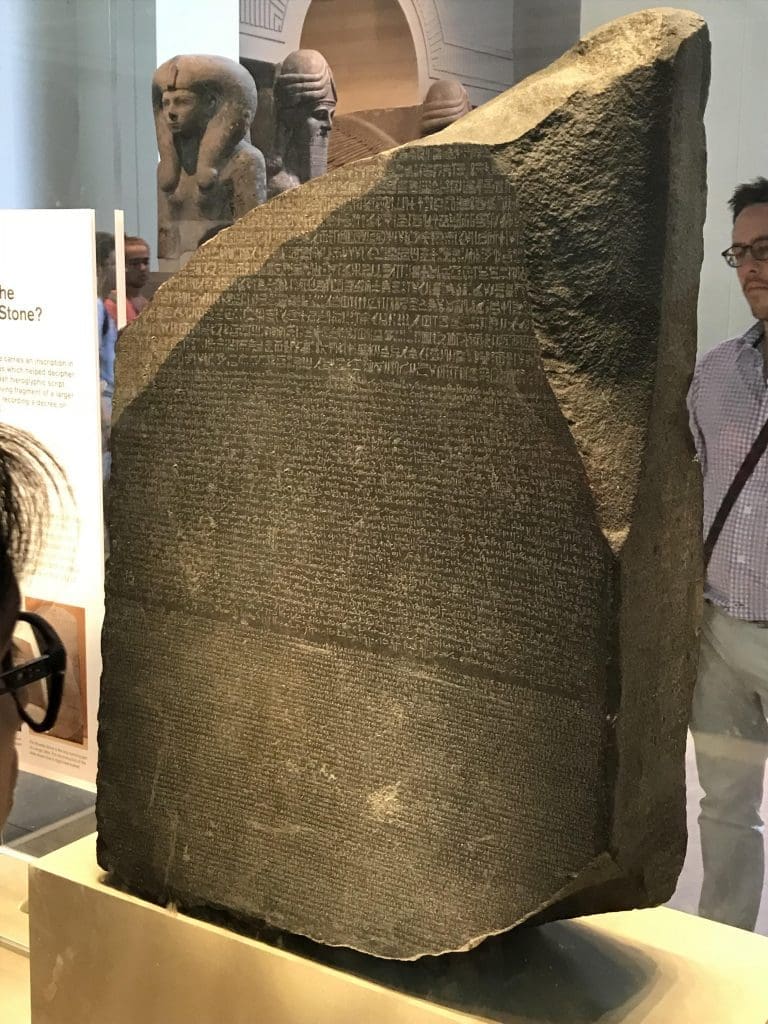
Today, we know that Abraham could not have written the papyri that Smith relied upon. The Church’s own essay on this topic confirms that the papyri “date to between the third century B.C.E. and the first century C.E., long after Abraham lived.”
- Dr. James H. Breasted, an esteemed professor who held the first chair in Egyptology and Oriental History in the United States, declared “Joseph Smith’s interpretations of [the documents] as part of a unique revelation through Abraham, therefore, very clearly demonstrates that he was totally unacquainted with the significance of these documents and absolutely ignorant of the simplest facts of Egyptian writing and civilization.”
- Dr. W.M. Flinders Petrie of London University asserts “It may be safely said that there is not one single word that is true in these explanations.”
- Dr. A.H. Sayce of Oxford University declares “It is difficult to deal seriously with Joseph Smith’s impudent fraud… Smith has turned the goddess [Isis in Facsimile No. 3] into a King and Osiris into Abraham.”
When the Church asked Hugh Nibley to look into the papyri, he sought the opinion of amateur Egyptologist Dee Jay Nelson. Nibley went on to praise Dee Jay Nelson’s work in the spring 1968 volume of BYU Studies: “This is a conscientious and courageous piece of work…Nelson has been careful to consult top-ranking scholars…” Unfortunately, Nelson promptly informed Nibley that the papyri were standard funerary script.
It seems evident that Nibley purposely avoided approaching academic experts directly because he was afraid of inviting further embarrassment. “We have often been asked during the past months why we did not proceed with all haste to produce a translation of the [Book of Abraham] papyri the moment they came into our possession. Well, for one thing others are far better equipped to do the job than we are, and some of those early expressed a willingness to undertake it. But, more important, it is doubtful whether any translation could do as much good as harm.” [7]
As evidence steadily compounded against the Book of Abraham’s authenticity, the Church later denounced Nibley’s endeavor as self-directed and unofficial, while attempting to minimize Dee’s credibility. This is a common strategy of the LDS Church. If the result of an academic’s work reflects positively on the Church, they publish it and take credit for it. If not, even when it originates from a Church-owned institution, they diminish it as “unofficial” and refuse to take responsibility for the results.
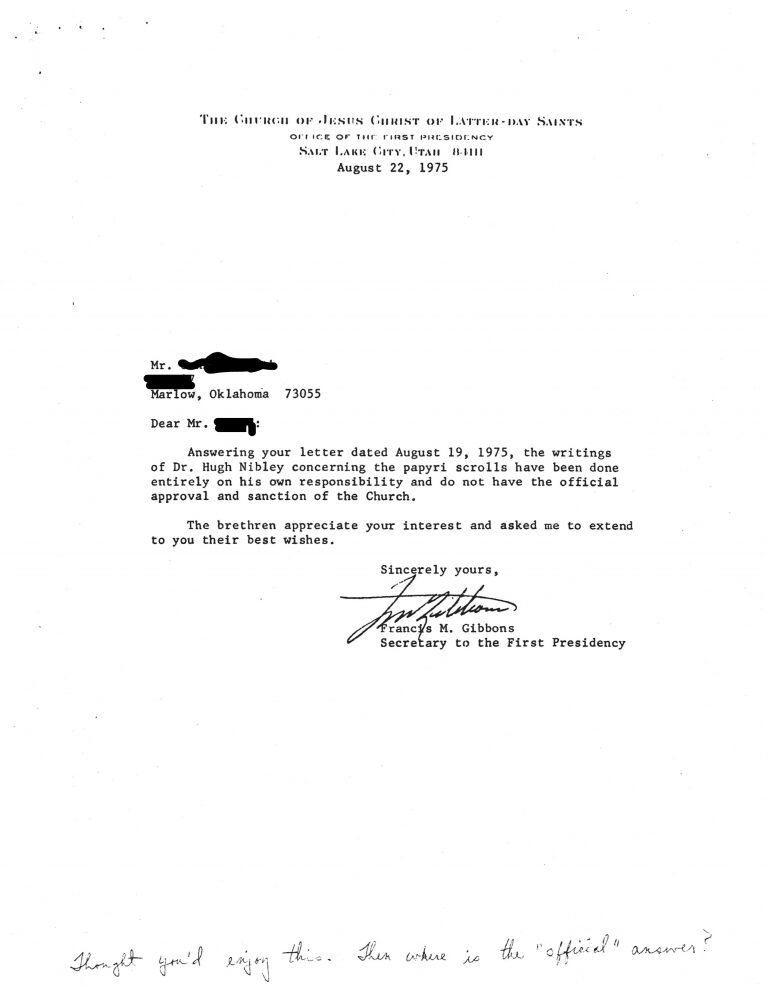
ALTERNATIVE THEORIES
THE SCROLLS
The LDS Church suggests that the original papyri scrolls must have been much longer than existing fragments, that “Only small fragments of the long papyrus scrolls once in Joseph Smith’s possession exist today.” The long scroll theory lacks both evidence and credibility, as Smith’s manuscript matches the papyrus fragments in the LDS Church’s possession. It remains clear to unbiased observers what Joseph was relying upon when his vivid imagination incorrectly propelled standard Egyptian funerary text into the Book of Abraham.
Another argument for an authentic Book of Abraham, which attempts to address the inconvenient recent vintage of the scrolls, asserts that the scrolls Smith used were copies of a preexisting text written by Abraham. Unfortunately for this hypothesis, no other previous copies of the claimed Book of Abraham have ever been discovered to fill the 16-century void from Abraham’s life to the Kirtland papyri created around 350 BCE. No chain of source documentation allows Abraham to have ever written the book that Joseph Smith claimed to have translated. Occam’s Razor suggests a simpler conclusion – that there were no other papyri and that Abraham did not write The Book of Abraham, but Joseph Smith did.
CATALYST THEORY
In its Gospel Topics Essay: Historicity of the Book of Abraham, the LDS Church suggests “The relationship of these documents to the book of Abraham is not fully understood.” It introduces what scholars call a ‘catalyst theory’ to hypothesize how Smith created the text through revelation from God, being inspired by the papyri artifacts. The Church now suggests that the entirety of the Book of Abraham came directly from revelation with no relationship to the actual meaning of the scrolls. To create room for an inspired narrative disconnected from the actual papyri Joseph clearly used, the Church altered the wording of the Pearl of Great Price introduction in 2013.
The catalyst argument is faulty, as Smith clearly believed the papyri to be authentic writings of Abraham, and relied upon them for many years to execute his translation. He even proudly displayed the papyri and mummies for visitors to examine. The catalyst theory is directly contradicted by Joseph’s own words, as recorded by his most trusted associates. “Joseph the Seer has presented us some of the Book of Abraham which was written by his own hand but hid from the knowledge of man for the last four thousand years but has now come to light through the mercy of God.” [8]
One would have to concede that God deceived his prophet, who clearly believed he was translating when in fact he was not. Damage is inflicted upon the catalyst theory by Joseph Smith himself, as he referred to specific hieroglyphics and then gave his “translation” of them, linking his “translation” to specific hieroglyphics on the extant papyri the church has in its possession. Why would the prophet call it a translation, and make so many assertions to that affect, while creating an inaccurate translation tool to facilitate his work? Why display so proudly the mummies and the papyri for visitors to admire, if the scrolls were not to be relied upon at all? If Smith was so wrong about the translation process itself, isn’t it reasonable to conclude that he may have been wrong about other things as well?
Further, the Book of Abraham text itself invalidates the catalyst theory. Abraham 1:12 links the text with the first of the facsimiles, stating that Abraham himself “will refer you to the representation at the commencement of this record… I have given you the fashion of them in the figures at the beginning…which signifies hieroglyphics.” In other words, the Book of Abraham itself states that Facsimile 1 was placed at the beginning of the record so that the reader could easily refer to it. It is directly related to the scroll it was attached to, the very same one Smith used to produce his narrative.
SHIFTING THE NARRATIVE
The original heading from the Phelps and Parrish copy of the manuscript stated, ”Translation of the Book of Abraham written by his own hand upon papyrus and found in the Catacombs of Egypt.” In its 2013 update of the standard works, the Church altered the introduction of the Pearl of Great Price. The previous description of the Book of Abraham read, “A translation from some Egyptian papyri that came into the hands of Joseph Smith in 1835, containing writings of the patriarch Abraham.” The recently modified description creates ambiguity regarding the origin and nature of the text; “An inspired translation of the writings of Abraham. Joseph Smith began the translation in 1835 after obtaining some Egyptian papyri.”
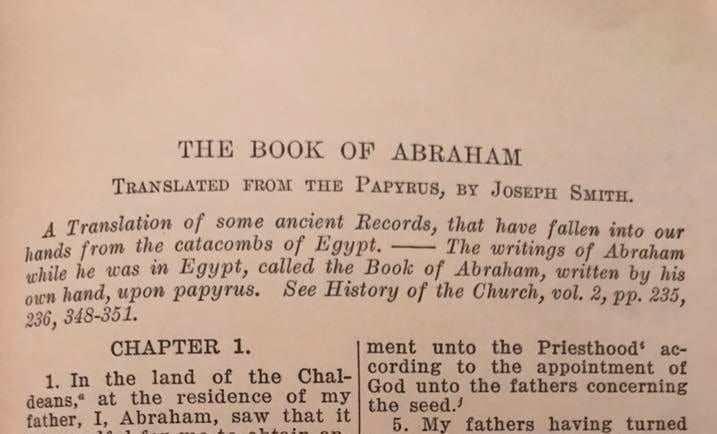
Some defenders of the authenticity of the Book of Abraham assert that the description in the Phelps and Parrish manuscript was merely their personal understanding of the papyrus, not Smith’s. They reference the 1842 Times and Seasons publication of the heading which is much closer to what’s published today, which reads: ”A translation of some ancient records that have fallen into our hands, from the Catecombs of Egypt, purporting to be the writings of Abraham, while he was in Egypt, called the Book of Abraham, written by his own hand, upon papyrus.” They argue that Joseph Smith approved the Times and Seasons description, but not necessarily the statement in the Phelps and Parrish manuscript. But if one reads further into the Times and Seasons description, we see that this apparent “catalyst” is still identified as “the writings of Abraham.”
None of these claims to explain the origins of the Book of Abraham have been advanced by any serious non-LDS Egyptologists. Only motivated reasoning allows for an authentic Book of Abraham as Joseph Smith claimed.
NINETEENTH CENTURY ORIGINS
The content of the Book of Abraham, which Joseph worked on for seven years, is largely accounted for by his use of five 19th Century sources. The books were readily available to Joseph in the Nauvoo library where he lived.
The evidence is thoroughly detailed in An Insiders View of Mormon Origins, Chapter 1.
- Abraham 1; Facsimile 1, 3:
Abraham’s biographical information in Abraham 1 and Smith’s claim of what these two Facsimiles portray comes from The Works of Flavius Josephus. Smith owned an 1830 edition of this book. Smith’s detailed explanations for the individual Egyptian characters on these two Facsimiles in the Book of Abraham have been thoroughly discredited by Egyptologists. - Abraham 2, 4-5:
Eighty-six percent of the verses in these three chapters came from Genesis, 1, 2, 12, and 11:28-29. The scribal errors indicate that this material came from a 1769 or later printing of the KJV Bible. - Abraham 3; Facsimile 2:
This text shares a remarkable resemblance to the astronomical concepts, phrases, and other motifs found in Thomas Dick’s, Philosophy of a Future State. Smith owned an 1830 copy of Dick’s book; a work which attempted to harmonize Christianty and science. - Abraham 3; Facsimile 2:
Thomas Taylor’s 1816 book, The Six Books of Proclus on the Theology of Plato, especially volume 2, contains most of the motifs in Abraham 3 and Facsimile 2. Dick and Taylor both contain a number of exact phrases found in Abraham 3 and Facsimile 2. Importantly, Smith’s Newtonian astronomy concepts, mechanics, and model of the universe that he borrowed from these Newtonian books have been thoroughly discredited by Einstein’s twentieth-century model of the universe. In summary, Smith’s ‘translation’ contains outdated notions rather than inspired truth from God.
Prominent LDS historians like Richard Bushman have called Joseph’s work Pseudepigrapha, a genre of writing in which the author falsely attributes the work to another, typically ancient, writer. Simply put, pseudepigrapha means Joseph Smith’s ‘translations’ are not what he claimed them to be.
LEARN MORE:
- Richard Bushman, New Perspectives on Joseph Smith and Translation
RACIAL DISCRIMINATION
The Book of Abraham constitutes a theological justification for the LDS Church’s long-standing racial discrimination against African-Americans, now admitted by the Church to be error or mere policy – though it was considered doctrine until 1978. The lifting of the race ban, as well as the Church’s Race and The Priesthood essay, effectively repudiate standing LDS scriptural doctrine.
For generations, many LDS prophets reiterated a doctrine professing that those who were valiant in the pre-existence were born white (and able-bodied) while those less valiant were born black and therefore unworthy of priesthood ordinances and temple attendance. The doctrine has since been disavowed.
QUESTIONABLE CONTEXT
The LDS essay Historicity of the Book of Abraham presents a number of problematic arguments and citations taken out of context. The Church promptly appeals to ignorance, as its second introductory paragraph, falsely suggests “no eyewitness account of the translation survives, making it impossible to reconstruct the process.” Yet in the very same essay, the Church avails itself of the firsthand account of Smith’s trusted scribe, Warren Parrish, who reported “I have set by his side and penned down the translation of the Egyptian hieroglyphics as he claimed to receive it by direct inspiration of Heaven…”
Taken out of context, the clipped quote implies that Parrish was reminiscing on his faithful translation labors with the prophet. But what are readers to make of his actual message in that letter to the Editor of the Painesville Republican in February of 1838? Warren was very clearly chastising Joseph Smith and Sidney Rigdon, because “Their management in this place has reduced society to a complete wreck.” He is not ambiguous in stating, “…having a knowledge of their private characters and sentiments, I believe them to be confirmed infidels, who have not the fear of God before their eyes, notwithstanding their high pretensions to holiness.” Parish further asserted that “For the past year their (Joseph Smith and Sidney Rigdon) lives have been one continued scene of lying, deception, and fraud, and that too in the name of God.”
Learn More: (Read the full Warren Parrish letter HERE)
CONCLUSION
For many Mormons, an examination of the Book of Abraham and its true history becomes the most significant stumbling block to Joseph Smith’s claim as a prophetic translator of ancient languages. Even brief investigations into the historicity of the Book of Abraham reveal glaring issues which often lead to the unravelling of other key LDS scripture.
Given the accumulation of evidence, it seems obvious that Joseph Smith was improvising with his own limited, nineteenth-century understanding of the ancient world and faulty views of the universe to create what today is understood to be harmful, sexist and prejudiced racial theories, combined with a polytheistic view of humanity that other Christian denominations find heretical.
There is no factual evidence to support the idea of a translation in any sense of that word; the book simply cannot be defended through any honest academic approach to Egyptology or scriptural scholarship as a legitimate historical document, written by the hand of Abraham. Even arguing that it is scripture, however God may have revealed it to Joseph Smith, is equally problematic. The Book of Abraham narrative demonstrates the manner in which the LDS Church works diligently to massage or reinterpret inconvenient facts to salvage even its most extraordinary truth claims.
LEARN MORE
- LDS Gospel Topics Essay – Translation & Historicity of Book of Abraham
- The Joseph Smith Papyri – Great video explaining things
- Problems with the Book of Abraham, Bill Reel
- Missing Scrolls, Catalyst Theories, and Bad Apologetics Part 1 – Radio Free Mormon: 049
- Robert Ritner Responds to LDS Abraham Essay
- Truth of Book of Abraham Part 1, Dan Vogel
- Truth of Book of Abraham Part 2, Dan Vogel
- Truth of Book of Abraham Part 3, Dan Vogel
- Truth of Book of Abraham Part 4, Dan Vogel
- Truth of Book of Abraham Part 5, Dan Vogel
- Truth of Book of Abraham Part 6, Dan Vogel
- Dialogue: The Joseph Smith Egyptian Papyri, 1967
- The Joseph Smith Papers, Book of Abraham Manuscript
- MormonThink – Book of Abraham Issues
- LDS Church is True: https://www.churchistrue.com/book-of-abraham/
- Cherry picking False Warren Parish Testimony
- Exploring Mormonism, The Man who Wrote LDS Abraham Essay
- Lost Book of Abraham Video
- History of the Church - https://byustudies.byu.edu/history-of-the-church
- Early Mormonism and the Magic World View, D. Michael Quinn
- Swedenborg Foundation
- Joseph’s Plagiarism in Book of Mormon and Other Revelations
- Did Emanuel Swedenborg Influence LDS Doctrine?
- Times and Seasons Vol. 3, No. 9, March 1, 1842
- Feb 1968 Improvement Era – New Light on Smith’s Papyri
- New York Times, Museum Walls Proclaim Fraud, 1912
- Philosophies of a Future State (vol. 1 & 2)
[1] History of the Church, vol 2: 236.
[2] Collected Works Of Hugh Nibley: An Approach To The Book Of Abraham, vol 18.
[3] An Insiders View of Mormon Origins, Grant Palmer.
[4] Translation and Historicity of the Book of Abraham – A Response, Robert K. Ritner
[5] Early Mormonism and the Magic World View, 244.
[6] History of the Church, 2:238.
[7] Hugh Nibley, BYU Studies, Spring 1968, 251.
[8] Journal of Wilford Woodruff.

